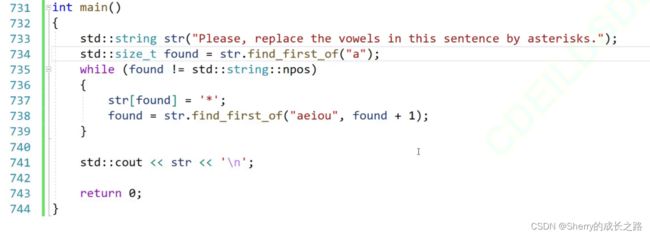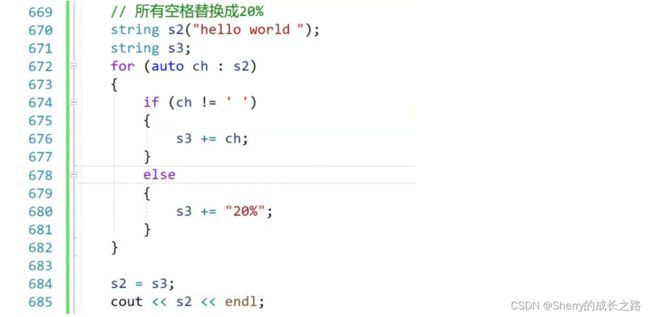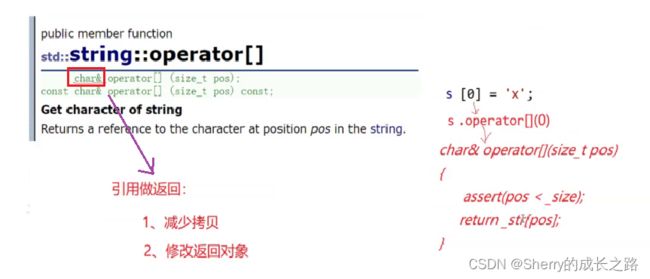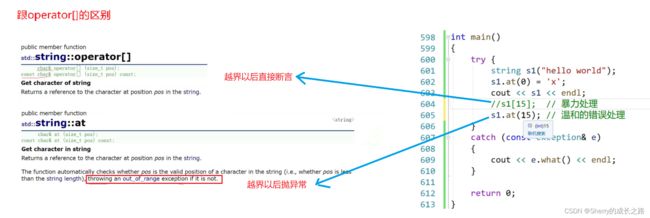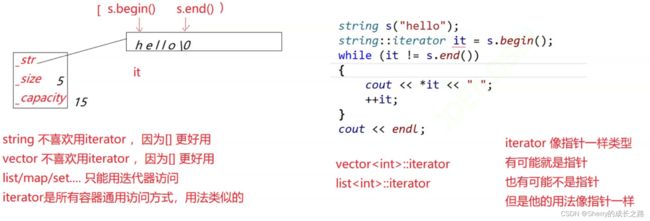【C++初阶】C++STL详解(一)—— string类
![]()
个人主页:@Sherry的成长之路
学习社区:Sherry的成长之路(个人社区)
专栏链接:C++初阶
长路漫漫浩浩,万事皆有期待
文章目录
- C++STL详解(一)—— sring类
- 1. string的定义方式
- 2. string的插入
- 3.string的拼接
- 4.string的删除
- 5.string的查找
- 6.string的比较
- 7.string的替换
- 8.string的交换
- 9.string的大小和容量
- 10.string中元素的访问
- 11.string中运算符的使用
- 12.string中与迭代器相关的函数
- 13.string与字符串之间的转换
- 14.string中子字符串的提取
- 15.string中的getline函数
- 16.总结:
C++STL详解(一)—— sring类
1. string的定义方式
string类实现了多个构造函数的重载,常用的构造函数如下:
string(); //构造一个空字符串
string(const char* s); //复制s所指的字符序列
string(const char* s, size_t n); //复制s所指字符序列的前n个字符
string(size_t n, char c); //生成n个c字符的字符串
string(const string& str); //生成str的复制品
string(const string& str, size_t pos, size_t len = npos); //复制str中从字符位置pos开始并跨越len个字符的部分
使用示例:
string s1; //构造空字符串
string s2("hello string"); //复制"hello string"
string s3("hello string", 3); //复制"hello string"的前3个字符
string s4(10, 's'); //生成10个's'字符的字符串
string s5(s2); //生成s2的复制品
string s6(s2, 0, 4); //复制s2中从字符位置0开始并跨越4个字符的部分
2. string的插入
1、使用push_back进行尾插–插入单个字符
append–插入字符串
void push_back (char c);
#include 2、使用insert插入
string& insert (size_t pos, const string& str);
string& insert (size_t pos, const char* s);
iterator insert (iterator p, char c);
#include 3.string的拼接
使用append函数完成string的拼接:
string& append (const string& str);
string& append (const char* s);
string& append (size_t n, char c);
#include 4.string的删除
1、使用pop_back进行尾删
void pop_back();
#include 2、使用erase删除
string& erase (size_t pos = 0, size_t len = npos);
iterator erase (iterator p);
iterator erase (iterator first, iterator last);
#include 5.string的查找
1、使用find函数正向搜索第一个匹配项
size_t find (const string& str, size_t pos = 0) const;
size_t find (const char* s, size_t pos = 0) const;
size_t find (char c, size_t pos = 0) const;
#include 2、使用rfind函数反向搜索第一个匹配项
size_t rfind (const string& str, size_t pos = npos) const;
size_t rfind (const char* s, size_t pos = npos) const;
size_t rfind (char c, size_t pos = npos) const;
#include size_t find_first_of (const string& str, size_t pos = 0) const;
size_t find_first_of (const char* s, size_t pos = 0) const;
size_t find_first_of (const char* s, size_t pos, size_t n) const;
size_t find_first_of (char c, size_t pos = 0) const;
正向查找在原字符串中第一个与指定字符串(或字符)中的某个字符匹配的字符,返回它的位置。若查找失败,则返回npos。(npos定义为保证大于任何有效下标的值。)
#include4、find_last_of()函数
size_t find_last_not_of (const string& str, size_t pos = npos) const;
size_t find_last_not_of (const char* s, size_t pos = npos) const;
size_t find_last_not_of (const char* s, size_t pos, size_t n) const;
size_t find_last_not_of (char c, size_t pos = npos) const;
逆向查找在原字符串中最后一个与指定字符串(或字符)中的某个字符匹配的字符,返回它的位置。若查找失败,则返回npos。(npos定义为保证大于任何有效下标的值。)
#include6.string的比较
使用compare函数完成比较:
int compare (const string& str) const;
int compare (size_t pos, size_t len, const string& str) const;
int compare (size_t pos, size_t len, const string& str, size_t subpos, size_t sublen) const;
比较规则:
1、比较字符串中第一个不匹配的字符值较小,或者所有比较字符都匹配,但比较字符串较短,则返回小于0的值。
2、比较字符串中第一个不匹配的字符值较大,或者所有比较字符都匹配,但比较字符串较长,则返回大于0的值。
3、比较的两个字符串相等,则返回0。
#include 注意:除了支持string类之间进行比较,compare函数还支持string类和字符串进行比较。
7.string的替换
使用replace函数完成string的替换:
string& replace (size_t pos, size_t len, const char* s);
string& replace (size_t pos, size_t len, size_t n, char c);
#include 但一般不使用repalce,因为要挪动数据,时间复杂度较高,而是通过空间换时间,比如下面这道题:
8.string的交换
使用swap函数完成两个string类的交换:
void swap (string& x, string& y);
void swap (string& str);
#include 9.string的大小和容量
1、使用size函数或length函数获取当前有效字符的个数
size_t size() const;
size_t length() const;
#include 2、使用max_size函数获取string对象对多可包含的字符数
size_t max_size() const;
#include 3、使用capacity函数获取当前对象所分配的存储空间的大小
size_t capacity() const;
#include 4、使用resize改变当前对象的有效字符的个数
void resize (size_t n);
void resize (size_t n, char c);
resize规则:
1、当n大于对象当前的size时,将size扩大到n,扩大的字符为c,若c未给出,则默认为’\0’。
2、当n小于对象当前的size时,将size缩小到n。
#include 注意:若给出的n大于对象当前的capacity,则capacity也会根据自己的增长规则进行扩大->进行开空间+初始化
5、使用reserve改变当前对象的容量大小
void reserve (size_t n = 0);
reserve规则:
1、当n大于对象当前的capacity时,将capacity扩大到n或大于n。
2、当n小于对象当前的capacity时,什么也不做。
注意:如果使用clear()清理了数据,会缩容,反之不会缩容;但不建议缩容,否则时间换空间(开辟小空间、拷贝、释放之前的大空间)->不值得
#include 注意:此函数对字符串的size没有影响,并且无法更改其内容。只进行开空间->减少消耗,提高效率
6、使用clear删除对象的内容,删除后对象变为空字符串
void clear();
#include 7、使用empty判断对象是否为空
bool empty() const;
#include 10.string中元素的访问
1、[ ]+下标
因为string类对[ ]运算符进行了重载,所以我们可以直接使用[ ]+下标访问对象中的元素。并且该重载使用的是引用返回,所以我们可以通过[ ]+下标修改对应位置的元素。
char& operator[] (size_t pos);
const char& operator[] (size_t pos) const;
#include 2、使用at访问对象中的元素
因为at函数也是使用的引用返回,所以我们也可以通过at函数修改对应位置的元素。
char& at (size_t pos);
const char& at (size_t pos) const;
#include 3、使用范围for访问对象中的元素
需要特别注意的是:若是需要通过范围for修改对象的元素,则用于接收元素的变量e的类型必须是引用类型,否则e只是对象元素的拷贝,对e的修改不会影响到对象的元素。
#include 其实,范围for的底层就是迭代器
4、使用迭代器访问对象中的元素
#include 11.string中运算符的使用
1、operator=
string类中对=运算符进行了重载,重载后的=运算符支持string类的赋值、字符串的赋值以及字符的赋值。
#include 2、operator+=
string类中对+=运算符进行了重载,重载后的+=运算符支持string类的复合赋值、字符串的复合赋值以及字符复合的赋值。
#include 其实,operator+=的底层就是调用的push_back和append
3、operator+
string类中对+运算符进行了重载,重载后的+运算符支持以下几种类型的操作:
string类 + string类
string类 + 字符串
字符串 + string类
string类 + 字符
字符 + string类
它们相加后均返回一个string类对象。
#include 4、operator>> 和 operator<<
string类中也对>>和<<运算符进行了重载,这就是为什么我们可以直接使用>>和<<对string类进行输入和输出的原因。
istream& operator>> (istream& is, string& str);
ostream& operator<< (ostream& os, const string& str);
#include 5、!=、<、<=、>等
string类中还对一系列关系运算符进行了重载,它们分别是==、!=、<、<=、>、>=。重载后的关系运算符支持string类和string类之间的关系比较、string类和字符串之间的关系比较、字符串和string类之间的关系比较。
#include 注意:这些重载的关系比较运算符所比较的都是对应字符的ASCII码值。
12.string中与迭代器相关的函数
1、与正向迭代器相关的函数
begin函数:返回一个指向字符串第一个字符的迭代器。
函数原型:
iterator begin();
const_iterator begin() const;
end函数:返回一个指向字符串结束字符的迭代器,即’\0’。
函数原型:
iterator end();
const_iterator end() const;
使用示例:
#include 2、与反向迭代器相关的函数
rbegin函数:返回指向字符串最后一个字符的反向迭代器。
函数原型:
reverse_iterator rbegin();
const_reverse_iterator rbegin() const;
rend函数:返回指向字符串第一个字符前面的理论元素的反向迭代器。
函数原型:
reverse_iterator rend();
const_reverse_iterator rend() const;
使用示例:
#include 13.string与字符串之间的转换
1、将字符串转换为string
将字符串转换为string很简单,在前面讲string的定义方式时就有说到。
#include 2、使用c_str或data将string转换为字符串
const char* c_str() const;
const char* data() const;
区别:
在C++98中,c_str()返回 const char* 类型,返回的字符串会以空字符结尾。
在C++98中,data()返回 const char* 类型,返回的字符串不以空字符结尾。
但是在C++11版本中,c_str()与data()用法相同。
#include 兼容C语言,相互配合:
C语言与C++中字符串读取结束的区别:
14.string中子字符串的提取
1、使用substr函数提取string中的子字符串
string substr (size_t pos = 0, size_t len = npos) const;
#include 2、使用copy函数将string的子字符串复制到字符数组中
size_t copy (char* s, size_t len, size_t pos = 0) const;
#include 15.string中的getline函数
在使用>>进行输入操作时,当>>读取到空格便会停止读取,基于此,我们将不能用>>将一串含有空格的字符串读入到string对象中。
#include 这时,我们就需要用getline函数完成一串含有空格的字符串的读取操作了。
用法一:
istream& getline (istream& is, string& str);
getline函数将从is中提取到的字符存储到str中,直到读取到换行符’\n’为止。
#include 用法二:
istream& getline (istream& is, string& str, char delim);
getline函数将从is中提取到的字符存储到str中,直到读取到分隔符delim或换行符’\n’为止。
#include 16.总结:
今天我们认识并具体学习了STL中string类,开启了STL学习的大门。接下来,我们将进行STL中string类的模拟实现。希望我的文章和讲解能对大家的学习提供一些帮助。
当然,本文仍有许多不足之处,欢迎各位小伙伴们随时私信交流、批评指正!我们下期见~
![]()
